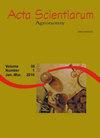玉米种子中黄萎病的分期检测与传播
IF 1.2
4区 农林科学
Q3 AGRONOMY
引用次数: 3
摘要
本研究的目的是评估在不同物候期接种玉米种子时黄萎病菌的传播率。分别在植株的V7、V9、R1、R2、R4和R6期接种病菌。实验在花盆中进行,采用完全随机设计,重复6次。通过卫生试验(Blotter test)验证了种子的真菌侵染率。不同物候期和两个试验(雨季和旱季)间的差异以及生产力的差异均表明黄萎病菌在所有物候期都能通过植物种子传播。PCR技术显示玉米种子中黄萎病菌的发病率最低,为1%。接种次数与菌种发病率之间存在显著差异。在两个试验中,在雨季(V7 - 48;V9 - 46;R1 - 77.33;R2 - 84;R4 - 96;R6 - 96.67;和Test - 14.67%),旱季(V7 - 46.67%;V9 - 66;R1 - 75.33;R2 - 95.33;R4 - 98;R6 - 97.33%)。本研究表明,在繁殖物候期R2、R4和R6,玉米植株对黄萎病菌的侵染更敏感,并导致籽粒产量下降。本文章由计算机程序翻译,如有差异,请以英文原文为准。
Detection and transmission of Fusarium verticillioides in corn seeds according to the plant stage
The objective of this study was to evaluate the transmissibility of F. verticillioides, in corn seeds, when inoculated in different phenological stages. The plants were inoculated with the pathogen at the following stages: V7, V9, R1, R2, R4, and R6. The experiments were conducted in pots, in a completely randomized design, with six replications. The fungus infection rate in the seeds was verified through the health test (Blotter Test). The significance of the contrast between the phenological stages and in the two experiments (rainy season and dry season), and productivity showed plant-seed transmission of F. verticillioides in all phenological stages. The PCR technique was able to reveal up to the lowest level, 1% incidence of F. verticillioides in corn seeds. There was a significant difference between the times of plant inoculation and the incidence of the fungus in the seeds. Plants inoculated in the reproductive phase transmitted F. verticillioides for seeds with the highest rate of infection, in the two experiments, in the rainy season (V7 - 48; V9 - 46; R1 - 77.33; R2 - 84; R4 - 96; R6 - 96.67; and Test - 14.67%), and dry season (V7 - 46.67; V9 - 66; R1 - 75.33; R2 - 95.33; R4 - 98; and R6 - 97.33%). In this way, the present work demonstrated that in the reproductive phenological stages R2, R4, and R6, the corn plant was more susceptible to infection with F. verticillioides, and that it also resulted in a decrease in grain productivity.
求助全文
通过发布文献求助,成功后即可免费获取论文全文。
去求助
来源期刊

Acta Scientiarum. Agronomy.
Agricultural and Biological Sciences-Agronomy and Crop Science
CiteScore
2.40
自引率
0.00%
发文量
45
审稿时长
>12 weeks
期刊介绍:
The journal publishes original articles in all areas of Agronomy, including soil sciences, agricultural entomology, soil fertility and manuring, soil physics, physiology of cultivated plants, phytopathology, phyto-health, phytotechny, genesis, morphology and soil classification, management and conservation of soil, integrated management of plant pests, vegetal improvement, agricultural microbiology, agricultural parasitology, production and processing of seeds.
 求助内容:
求助内容: 应助结果提醒方式:
应助结果提醒方式:


